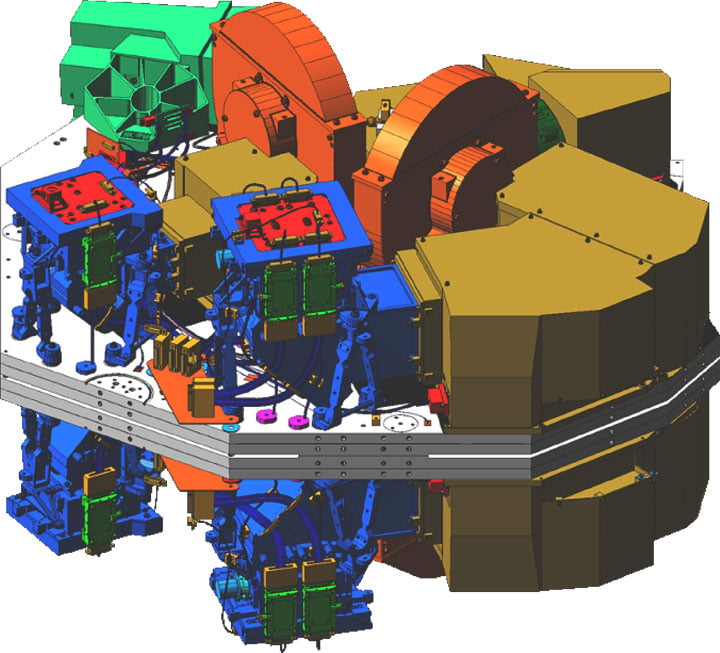In the first data taken last summer with the Near Infrared Camera (NIRCam) on the new James Webb Space Telescope, astronomers found six galaxies from a time when the Universe was only 3% of its current age, just 500-700 million years after the Big Bang. While its incredible JWST saw these galaxies from so long ago, the data also pose a mystery.
These galaxies should be mere infants, but instead they resemble galaxies of today, containing 100 times more stellar mass than astronomers were expecting to see so soon after the beginning of the Universe. If confirmed, this finding calls into question the current thinking of galaxy formation and challenges most models of cosmology.
"These objects are way more massive than anyone expected," said Joel Leja, assistant professor of astronomy and astrophysics at Penn State, who modeled light from these galaxies. "We expected only to find tiny, young, baby galaxies at this point in time, but we've discovered galaxies as mature as our own in what was previously understood to be the dawn of the universe."
The data was taken by JWST as part of the Cosmic Evolution Early Release Science (CEERS) program and was the first dataset released as part of the telescope's early release program, which is helping to showcase the new telescope's observing capabilities and allow the astronomical community to learn how to get the most out of their observing time with the various instruments.
NIRCam's infrared eyes are capable of detecting light that was emitted by the oldest stars and galaxies, allowing scientists to see back in time roughly 13.5 billion years, near the beginning of the universe as we know it. The targeted area of the sky for these sets of observations was a "blank" field – where no stars or galaxies had ever been seen before -- and overlapped with existing Hubble Space Telescope (HST) imaging.
While large galaxies with stellar masses as high as 100 billion times that of the Sun have been identified previously at approximately one billion years after the Big Bang, it has been difficult to find massive galaxies at even earlier times, the team wrote in their paper, published in Nature.
Within the JWST early release observation data, the team searched for intrinsically high redshifted galaxies in the first 500- 750 million years of cosmic history. Redshift is a measure of the age of an astronomical object, as due to the expansion of the Universe, light from distant objects shifts to wavelengths towards the red end of the spectrum. The redder the image, the more distant the object is.
They found six candidate massive galaxies at high redshifts (z = 6.5 and z = 9.1), with masses up to ten billion times that of our Sun, including one galaxy with a possible stellar mass 100 billion times that of the Sun. This is much bigger than anticipated.
"We looked into the very early universe for the first time and had no idea what we were going to find," Leja said, in a press release. "It turns out we found something so unexpected it actually creates problems for science. It calls the whole picture of early galaxy formation into question."
Leja explained that the galaxies the team discovered are so massive that they are in conflict with 99% of models for cosmology. Accounting for such a high amount of mass would require either altering the models for cosmology or revising the scientific understanding of galaxy formation in the early universe. Either scenario requires a fundamental shift in our understanding of how the universe came to be, he added.
However, the team needs more observations and data to confirm their findings, and admitted more data might reveal other explanations for what they found.
"This is our first glimpse back this far, so it's important that we keep an open mind about what we are seeing," Leja said. "While the data indicates they are likely galaxies, I think there is a real possibility that a few of these objects turn out to be obscured supermassive black holes. Regardless, the amount of mass we discovered means that the known mass in stars at this period of our universe is up to 100 times greater than we had previously thought. Even if we cut the sample in half, this is still an astounding change."
The plan is to take more data on these galaxies with NIRCam, and which will provide more details on how and distant these galaxies are. and how far away they are.
"What's funny is we have all these things we hope to learn from James Webb and this was nowhere near the top of the list," Leja said. "We've found something we never thought to ask the universe — and it happened way faster than I thought, but here we are."
Further reading:
Penn State press release
Nature paper
 Universe Today
Universe Today

